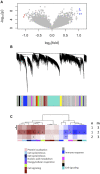Gene Expression Signatures Identify Biologically Homogenous Subgroups of Grade 2 Meningiomas
- PMID: 33224871
- PMCID: PMC7674612
- DOI: 10.3389/fonc.2020.541928
Gene Expression Signatures Identify Biologically Homogenous Subgroups of Grade 2 Meningiomas
Abstract
Introduction: Meningiomas are the most common brain tumor, with prevalence of approximately 3%. Histological grading has a major role in determining treatment choice and predicting outcome. While indolent grade 1 and aggressive grade 3 meningiomas exhibit relatively homogeneous clinical behavior, grade 2 meningiomas are far more heterogeneous, making outcome prediction challenging. We hypothesized two subgroups of grade 2 meningiomas which biologically resemble either World Health Organization (WHO) grade 1 or WHO grade 3. Our aim was to establish gene expression signatures that separate grade 2 meningiomas into two homogeneous subgroups: a more indolent subtype genetically resembling grade 1 and a more aggressive subtype resembling grade 3.
Methods: We carried out an observational meta-analysis on 212 meningiomas from six distinct studies retrieved from the open-access platform Gene Expression Omnibus. Microarray data was analyzed with systems-level gene co-expression network analysis. Fuzzy C-means clustering was employed to reclassify 34 of the 46 grade 2 meningiomas (74%) into a benign "grade 1-like" (13/46), and malignant "grade 3-like" (21/46) subgroup based on transcriptomic profiles. We verified shared biology between matching subgroups based on meta-gene expression and recurrence rates. These results were validated further using an independent RNA-seq dataset with 160 meningiomas, with similar results.
Results: Recurrence rates of "grade 1-like" and "grade 3- like" tumors were 0 and 75%, respectively, statistically similar to recurrence rates of grade 1 (17%) and 3 (85%). We also found overlapping biological processes of new subgroups with their adjacent grades 1 and 3.
Conclusion: These results underpin molecular signatures as complements to histological grading systems. They may help reshape prediction, follow-up planning, treatment decisions and recruitment protocols for future and ongoing clinical trials.
Keywords: bioinformatics; gene expression networks; marker discovery; meningioma; transcriptomics.
Copyright © 2020 Zador, Landry, Saha and Cusimano.
Figures




Similar articles
-
Transcriptomic analysis of aggressive meningiomas identifies PTTG1 and LEPR as prognostic biomarkers independent of WHO grade.Oncotarget. 2016 Mar 22;7(12):14551-68. doi: 10.18632/oncotarget.7396. Oncotarget. 2016. PMID: 26894859 Free PMC article.
-
The Discrepancy Between Standard Histologic WHO Grading of Meningioma and Molecular Profile: A Single Institution Series.Front Oncol. 2022 Mar 1;12:846232. doi: 10.3389/fonc.2022.846232. eCollection 2022. Front Oncol. 2022. PMID: 35299730 Free PMC article.
-
Microarray gene expression profiling in meningiomas: differential expression according to grade or histopathological subtype.Int J Oncol. 2009 Dec;35(6):1395-407. doi: 10.3892/ijo_00000457. Int J Oncol. 2009. PMID: 19885562
-
Risk Factors for High-Grade Meningioma in Brain and Spine: Systematic Review and Meta-analysis.World Neurosurg. 2021 Jul;151:e718-e730. doi: 10.1016/j.wneu.2021.04.138. Epub 2021 May 8. World Neurosurg. 2021. PMID: 33974984
-
Meta-analysis of adjuvant radiotherapy for intracranial atypical and malignant meningiomas.J Neurooncol. 2021 Apr;152(2):205-216. doi: 10.1007/s11060-020-03674-7. Epub 2021 Feb 26. J Neurooncol. 2021. PMID: 33635510 Review.
Cited by
-
MicroRNAs miR-16 and miR-519 control meningioma cell proliferation via overlapping transcriptomic programs shared with the RNA-binding protein HuR.Front Oncol. 2023 Aug 2;13:1158773. doi: 10.3389/fonc.2023.1158773. eCollection 2023. Front Oncol. 2023. PMID: 37601663 Free PMC article.
-
Integrated computational analyses reveal novel insights into the stromal microenvironment of SHH-subtype medulloblastoma.Sci Rep. 2021 Oct 19;11(1):20694. doi: 10.1038/s41598-021-00244-3. Sci Rep. 2021. PMID: 34667228 Free PMC article.
-
The integrated multiomic diagnosis of sporadic meningiomas: a review of its clinical implications.J Neurooncol. 2022 Jan;156(2):205-214. doi: 10.1007/s11060-021-03874-9. Epub 2021 Nov 30. J Neurooncol. 2022. PMID: 34846640 Free PMC article. Review.
-
m6A Regulator Expression Segregates Meningiomas Into Biologically Distinct Subtypes.Front Oncol. 2021 Dec 22;11:760892. doi: 10.3389/fonc.2021.760892. eCollection 2021. Front Oncol. 2021. PMID: 35004283 Free PMC article.
References
LinkOut - more resources
Full Text Sources

